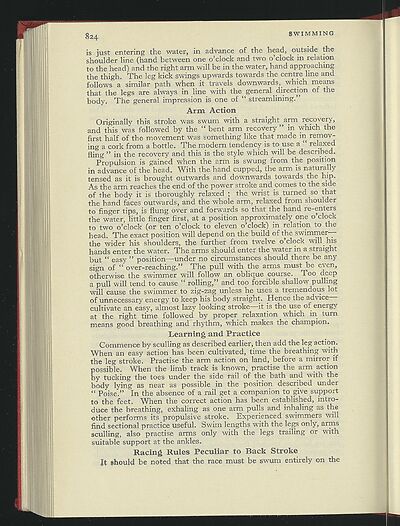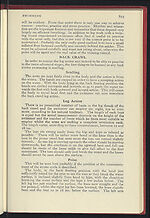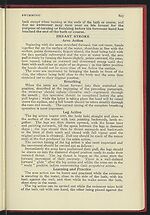1959-60
(900)
Download files
Complete book:
Individual page:
Thumbnail gallery: Grid view | List view

824
SWIMMING
is just entering the water, in advance of the head, outside the
shoulder line (hand between one o'clock and two o'clock in relation
to the head) and the right arm will be in the water, hand approaching
the thigh. The leg kick swings upwards towards the centre line and
follows a similar path when it travels downwards, which means
that the legs are always in line with the general direction of the
body. The general impression is one of " streamlining."
Arm Action
Originally this stroke was swum with a straight arm recovery,
and this was followed by the " bent arm recovery " in which the
first half of the movement was something like that made in remov-
ing a cork from a bottle. The modern tendency is to use a " relaxed
fling " in the recovery and this is the style which will be described.
Propulsion is gained when the arm is swung from the position
in advance of the head. With the hand cupped, the arm is naturally
tensed as it is brought outwards and downwards towards the hip.
As the arm reaches the end of the power stroke and comes to the side
of the body it is thoroughly relaxed ; the wrist is turned so that
the hand faces outwards, and the whole arm, relaxed from shoulder
to finger tips, is flung over and forwards so that the hand re-enters
the water, little finger first, at a position approximately one o'clock
to two o'clock (or ten o'clock to eleven o'clock) in relation to the
head. The exact position will depend on the build of the swimmer—
the wider his shoulders, the further from twelve o'clock will his
hands enter the water. The arms should enter the water in a.straight
but " easy " position—under no circumstances should there be any
sign of " over-reaching." The pull with the arms must be even,
otherwise the swimmer will follow an oblique course. Too deep
a pull will tend to cause " rolling," and too forcible shallow pulling
will cause the swimmer to zig-zag unless he uses a tremendous lot
of unnecessary energy to keep his body straight. Hence the advice—
cultivate an easy, almost lazy looking stroke—it is the use of energy
at the right time followed
by
proper relaxation which in turn
means good breathing and rhythm, which makes the champion.
Learning and Practice
Commence by sculling as described earlier, then add the leg action.
When an easy action has been cultivated, time the breathing with
the leg stroke. Practise the arm action on land, before a mirror if
possible. When the limb track is known, practise the arm action
by tucking the toes under the side rail of the bath and with the
body lying as near as possible in the position described under
" Poise." In the absence of a rail get a companion to give support
to the feet. When the correct action has been established, intro-
duce the breathing, exhaling as one arm pulls and inhaling as the
other performs its propulsive stroke. Experienced swimmers will
find sectional practice useful. Swim lengths with the legs only, arms
sculling, also practise arms only with the legs trailing or with
suitable support at the ankles.
Racing Rules Peculiar to Back Stroke
It should
be noted that the race must be swum entirely on the
SWIMMING
is just entering the water, in advance of the head, outside the
shoulder line (hand between one o'clock and two o'clock in relation
to the head) and the right arm will be in the water, hand approaching
the thigh. The leg kick swings upwards towards the centre line and
follows a similar path when it travels downwards, which means
that the legs are always in line with the general direction of the
body. The general impression is one of " streamlining."
Arm Action
Originally this stroke was swum with a straight arm recovery,
and this was followed by the " bent arm recovery " in which the
first half of the movement was something like that made in remov-
ing a cork from a bottle. The modern tendency is to use a " relaxed
fling " in the recovery and this is the style which will be described.
Propulsion is gained when the arm is swung from the position
in advance of the head. With the hand cupped, the arm is naturally
tensed as it is brought outwards and downwards towards the hip.
As the arm reaches the end of the power stroke and comes to the side
of the body it is thoroughly relaxed ; the wrist is turned so that
the hand faces outwards, and the whole arm, relaxed from shoulder
to finger tips, is flung over and forwards so that the hand re-enters
the water, little finger first, at a position approximately one o'clock
to two o'clock (or ten o'clock to eleven o'clock) in relation to the
head. The exact position will depend on the build of the swimmer—
the wider his shoulders, the further from twelve o'clock will his
hands enter the water. The arms should enter the water in a.straight
but " easy " position—under no circumstances should there be any
sign of " over-reaching." The pull with the arms must be even,
otherwise the swimmer will follow an oblique course. Too deep
a pull will tend to cause " rolling," and too forcible shallow pulling
will cause the swimmer to zig-zag unless he uses a tremendous lot
of unnecessary energy to keep his body straight. Hence the advice—
cultivate an easy, almost lazy looking stroke—it is the use of energy
at the right time followed
by
proper relaxation which in turn
means good breathing and rhythm, which makes the champion.
Learning and Practice
Commence by sculling as described earlier, then add the leg action.
When an easy action has been cultivated, time the breathing with
the leg stroke. Practise the arm action on land, before a mirror if
possible. When the limb track is known, practise the arm action
by tucking the toes under the side rail of the bath and with the
body lying as near as possible in the position described under
" Poise." In the absence of a rail get a companion to give support
to the feet. When the correct action has been established, intro-
duce the breathing, exhaling as one arm pulls and inhaling as the
other performs its propulsive stroke. Experienced swimmers will
find sectional practice useful. Swim lengths with the legs only, arms
sculling, also practise arms only with the legs trailing or with
suitable support at the ankles.
Racing Rules Peculiar to Back Stroke
It should
be noted that the race must be swum entirely on the
Set display mode to:
![]() Universal Viewer |
Universal Viewer | ![]() Mirador |
Large image | Transcription
Mirador |
Large image | Transcription
| Games and sports in the army > 1959-60 > (900) |
|---|
| Permanent URL | https://digital.nls.uk/248874738 |
|---|
| Description | 'Games and Sports in the Army' was an annual publication produced by the British War Office between the 1930s and 1960s. This included the Second World War. It outlines the rules and regulations for games and sports played by members of the armed forces. It features names and photographs of team members, and examples of contemporary advertising. |
|---|---|
| Shelfmark | GWB.52 |

